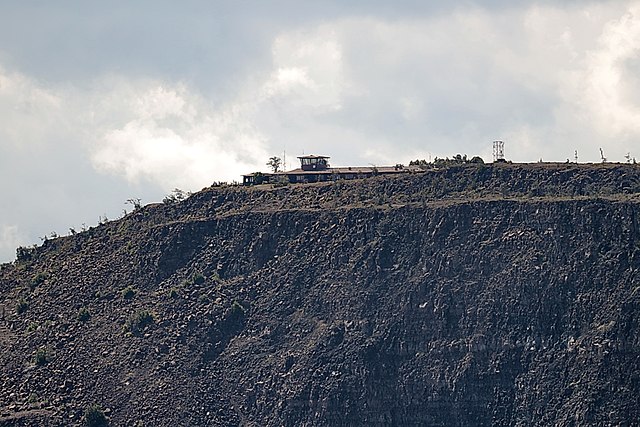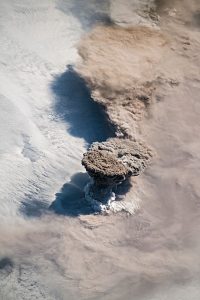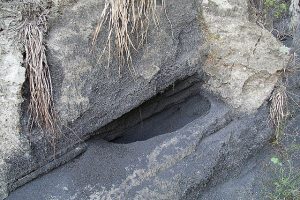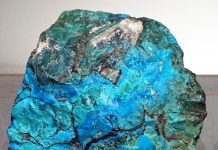
By Jim Brace-Thompson
A Dramatic Volcanic Eruption Captured from Space
Talk about timing! What do you get when the orbit of a space station zipping high above Earth intersects with a belch from deep beneath Earth? Answer: One dramatic photo that is immediately posted all around the Earth!
Meet Raikoke. This remote volcanic island last erupted 95 years ago, in 1924. (Before that, its last recorded eruption was 1778.) In the time since it has apparently pent up quite some anxiety. On June 22, it erupted with an ash plume that rose 42,700 feet, forming a glorious mushroom cloud of gas, ash, and volcanic glass visible to astronauts aboard the International Space Station. The image also was caught by several unmanned satellites.

Fortunately, Raikoke—situated in the northwest Pacific as part of the Kuril Islands archipelago between Russia’s Kamchatka Peninsula and Japan’s Hokkaido—is a small, uninhabited island. Thus, the eruption (actually, a pulse of at least nine separate explosions) resulted in no fatalities, injuries, or damage.
Still, the ash cloud created so-called dirty thunderstorms and is being monitored as it combines with storm clouds and drifts through the stratosphere at levels of as much as 8 to 10 miles. Its ash is also flowing across the sky at levels where commercial jets fly. At these levels, volcanic plumes tend to stay aloft longer than plumes at lower levels, and they tend to have greater impacts on climate and aviation.
Interestingly, such volcanic ash plumes can have opposing effects on our planet. On the one hand, eruptions that are powerful enough to reach the stratosphere can release significant amounts of carbon dioxide, which causes global warming. But they also release sulfur dioxide, a gas that promotes global cooling. The long-term impact of Raikoke’s belch is anyone’s guess!
Hawaii’s Mauna Loa Volcano Turns Yellow
The Mauna Loa Volcano on the Big Island of Hawaii is the biggest active volcano on our planet. Since active records have been maintained starting in 1843, this monster has erupted no less than 33 times!
Scientists have devised a color-coded system of alert levels for those living within the shadow of an active volcano like Mauna Loa. These range as follows: green (normal—no need to worry; nothing unusual is occurring), yellow (advisory—a volcano is deemed restless), orange (watch—there are signs of significant activity, such as frequent earthquakes or unusually large emissions of gas, steam, and heat); and red (warning—an eruption is in progress and it is past time to evacuate).
The alert level for Mauna Loa has recently been elevated from normal to advisory. Not yet time to panic and run, but perhaps time to pack a few bags and gather the wedding photos. Scientists from the Hawaiian Volcano Observatory (HVO) say that for the past few months the ground around the volcano has been deforming and the number of small earthquakes has been increasing at a rate “exceeding long term background levels”. The number of shallow earthquakes is similar to numbers recorded before eruptions in 1975 and 1984.
These indicators suggest the volcano’s underground magma storage system may indeed be filling and recharging. Whether this means the volcano will erupt any time soon is unknown. The current level of activity could continue for months or even years without an eruption. Still, given the history of volcanic activity on the Big Island of Hawaii, stay tuned! How to do so? Monitor the HVO website http://hvo.wr.usgs.gov/activity/maunaloastatus.php.
Stromboli Erupts Yet Again
Within the formal scientific field of volcanology, the Stromboli Volcano of Sicily stands out. It has shared its name to the technical term “Strombolian eruption”. This was defined by Italian volcanologist Giuseppe Mercalli as “mildly explosive at discrete but fairly regular intervals”.

Such eruptions spit out incandescent cinders and lava “bombs” that land hundreds of meters from the central cone and they often are accompanied by lava fountains and flows and ashfall. The activity of such a volcano can be long-lasting, building up a central cone from cinders shot forth during multiple eruptions. In the case of Stromboli, such eruptions have occurred repeatedly for some 2,000 years! In recent times, the volcano has been erupting more-or-less continuously since 1934.
After something of a pause in recent years, Stromboli is at it again. It stirred dramatically to life on July 3. Two powerful explosions sent forth a mushroom cloud thousands of feet into the sky that could be seen from miles away and that set off panic among tourists vacationing in the area, some of whom threw themselves into the sea. As many as 70 locals and tourists were immediately evacuated, and an Italian navy boat was commissioned should there be a need for a mass evacuation. Sadly, the eruption also cost the life of a resident from Sicily who was hiking on a side of the volcano when he and a fellow hiker encountered a rain of rocks and lapilli.
A local priest was reported by Italian news agencies as saying, “It was like being in hell because of the rain of fire coming from the sky”. Others reported hearing a large roar and later being engulfed in a cloud of ash that blanketed the entire sky. Marco Giorgianni, a local mayor from Lipari, was reported as saying, “a part of the island covered with a thick blanket of pumice looks like a postwar scene”.
In addition to the plumes belched skyward, red-hot lava spilled from the cater of one of the most continuously active volcanoes on our planet Earth. Watch for more news to come from one of the most infamous smoking mountains!















